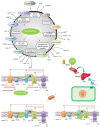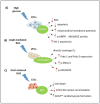Pathophysiological Basis for Nutraceutical Supplementation in Heart Failure: A Comprehensive Review
- PMID: 33477388
- PMCID: PMC7829856
- DOI: 10.3390/nu13010257
Pathophysiological Basis for Nutraceutical Supplementation in Heart Failure: A Comprehensive Review
Abstract
There is evidence demonstrating that heart failure (HF) occurs in 1-2% of the global population and is often accompanied by comorbidities which contribute to increasing the prevalence of the disease, the rate of hospitalization and the mortality. Although recent advances in both pharmacological and non-pharmacological approaches have led to a significant improvement in clinical outcomes in patients affected by HF, residual unmet needs remain, mostly related to the occurrence of poorly defined strategies in the early stages of myocardial dysfunction. Nutritional support in patients developing HF and nutraceutical supplementation have recently been shown to possibly contribute to protection of the failing myocardium, although their place in the treatment of HF requires further assessment, in order to find better therapeutic solutions. In this context, the Optimal Nutraceutical Supplementation in Heart Failure (ONUS-HF) working group aimed to assess the optimal nutraceutical approach to HF in the early phases of the disease, in order to counteract selected pathways that are imbalanced in the failing myocardium. In particular, we reviewed several of the most relevant pathophysiological and molecular changes occurring during the early stages of myocardial dysfunction. These include mitochondrial and sarcoplasmic reticulum stress, insufficient nitric oxide (NO) release, impaired cardiac stem cell mobilization and an imbalanced regulation of metalloproteinases. Moreover, we reviewed the potential of the nutraceutical supplementation of several natural products, such as coenzyme Q10 (CoQ10), a grape seed extract, Olea Europea L.-related antioxidants, a sodium-glucose cotransporter (SGLT2) inhibitor-rich apple extract and a bergamot polyphenolic fraction, in addition to their support in cardiomyocyte protection, in HF. Such an approach should contribute to optimising the use of nutraceuticals in HF, and the effect needs to be confirmed by means of more targeted clinical trials exploring the efficacy and safety of these compounds.
Keywords: dysfunctional cardiomyocytes; heart failure; nutraceuticals; oxidative stress; patho-physiological mechanisms.
Conflict of interest statement
The authors declare no conflict of interest.
Figures


References
-
- Nieminen M.S., Brutsaert D., Dickstein K., Drexler H., Follath F., Harjola V.P., Hochadel M., Komajda M., Lassus J., Lopez-Sendon J.L., et al. EuroHeart Failure Survey II (EHFS II): A survey on hospitalized acute heart failure patients: Description of population. Eur. Heart J. 2006;27:2725–2736. doi: 10.1093/eurheartj/ehl193. - DOI - PubMed
Publication types
MeSH terms
Substances
Grants and funding
LinkOut - more resources
Full Text Sources
Other Literature Sources
Medical
Research Materials
Miscellaneous

